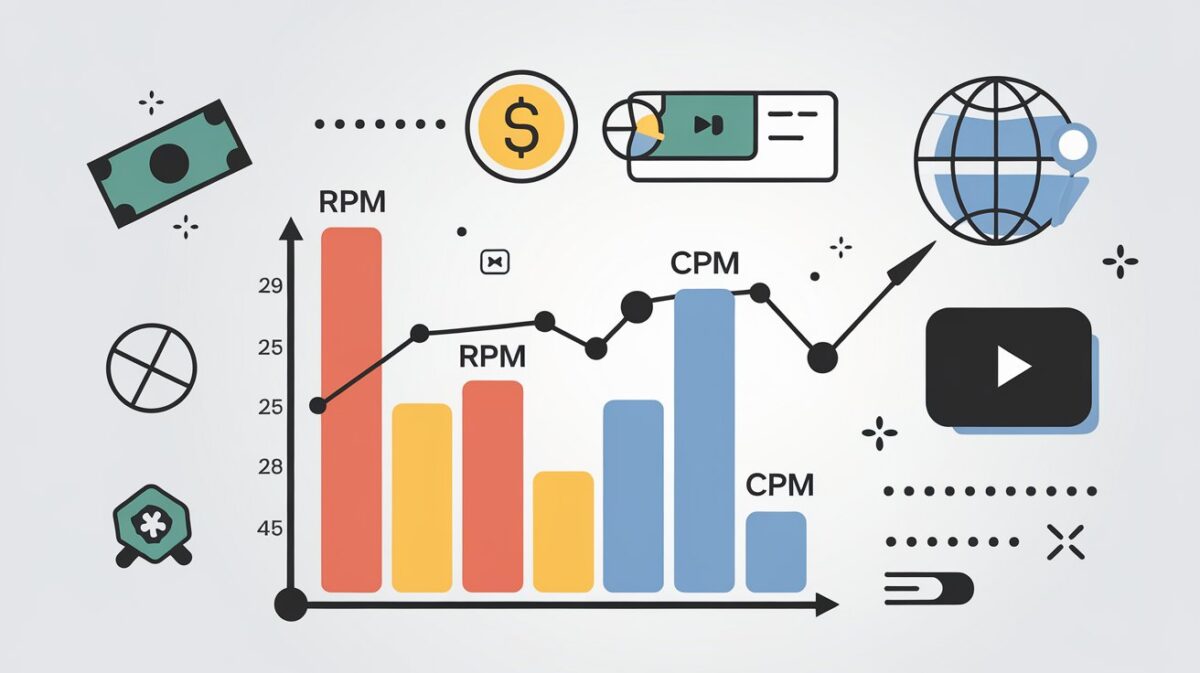Understanding YouTube RPM vs. CPM: A Complete Guide for Content Creators

YouTube RPM vs CPM

If you’re someone trying to make it big, as a YouTube content creator or already in the game, chances are you’ve stumbled upon terms like CPM and RPM before. These terms play a role in figuring out how much money you make from your YouTube channel. In this guide, we’ll explain what CPM and RPM stand for, how they’re not the thing, and why they’re super important when it comes to your earnings from YouTube.
What Is CPM?
Cost per mile (CPM) stands for the price that advertisers are ready to shell out for every 1000 ad views they get. It shows the amount brands and advertisers fork out to YouTube for featuring ads in videos. The CPM rate fluctuates based on factors such as where the audience is located and the video’s niche and seasonal timing. For instance, the CPM rate in India is not the same as that in the United States. Rates tend to be higher in the U.S. due to a surge in demand from advertisers.
Key Influencers on CPM:
- Geographical Location: CPM rates in the U.S. are often higher than those in developing countries like India.
- Niche: Content about finance, real estate, and technology tends to have a high CPM. A high-CPM niche on YouTube means advertisers see more value in reaching these audiences, which results in higher payouts.
- Time of Year: During the holiday season, CPM can increase as advertisers spend more on campaigns. The highest CPM on YouTube often occurs during Q4, especially around Black Friday and Christmas.
For instance, YouTube CPM in India for general content may range from $0.20 to $1.50 per 1,000 views, while CPM in the U.S. for the same content could go from $2 to $10.
What Is RPM?
Revenue Per Mille (RPM) is a metric that shows how much money creators make for every 1,000 views on YouTube after deducting YouTube’s share of the revenue earned from ad revenues such as channel memberships and other sources of income on the platform, i.e. sponsored content or merchandise sales RPM is an indicator of a creators earnings compared to CPM since it considers total views rather than just ad impressions alone.
How Is RPM Calculated?
The formula for RPM is:

Key Differences Between CPM and RPM
- Perspective: CPM is advertiser-focused, representing the amount paid per 1,000 ad impressions, whereas RPM is creator-focused, showing earnings per 1,000 views.
- Earnings Impact: RPM is generally lower than CPM because it considers YouTube’s revenue share. YouTube typically takes a 45% cut, meaning RPM is what remains for the creator.
- Dependence on Views: RPM provides a realistic measure of income for creators, as it accounts for all revenue streams based on total views, not just ads.
Understanding RPM and CPM in India vs. Other Countries
Regarding YouTube income in India, CPM and RPM rates tend to be lower than in Western countries. For instance, YouTube RPM in India may range between $0.50 and $1.50 for some niches, while YouTube RPM by country can vary, with the U.S. and Canada showing significantly higher rates.
Creators aiming to earn more can increase their earnings by tailoring content for high-CPM regions or engaging in high-RPM niches. This is why some channels create English content, catering to audiences in countries with higher CPM and RPM.
Highest YouTube RPM Niches
Understanding YouTube’s highest RPM niches can make a big difference for creators looking to maximize earnings. Here are some top categories with competitive RPM rates:
- Finance & Investment: $20–$50 RPM
- Real Estate: $15–$35 RPM
- Tech & Gadgets: $10–$25 RPM
- E-commerce: $12–$30 RPM
- Digital Marketing: $10–$20 RPM
How Much Can You Earn? 1 Million Views on YouTube Money
Earnings from 1 million YouTube views vary widely based on niche, location, and audience engagement. Here’s an estimate based on average RPM values:
- In India: You might earn around ₹20,000 to ₹70,000 (or roughly $250–$850) for 1 million views, depending on the topic and CPM rates in India.
- In the U.S.: A similar video could bring in $3,000–$10,000, thanks to higher RPM and CPM rates.
For creators looking to boost earnings from YouTube, focusing on high-RPM and high-CPM niches, as well as targeting international audiences, can help optimize income.
Practical Tips to Boost Your RPM and CPM
- Select High-CPM Niches: Content in finance, tech, and e-commerce usually attracts higher ad bids, increasing CPM and RPM.
- Optimize Audience Location: Tailoring content for viewers in high-CPM regions (like the U.S. and U.K.) can boost ad revenue.
- Engagement is Key: More engagement leads to more ads being served and viewed, boosting CPM.
- Utilize YouTube RPM Calculators: Tools like the YouTube RPM Calculator can give you estimates based on region and niche, allowing you to predict potential earnings and make informed content decisions.
Conclusion
Knowing about CPM and RPM can help you stand out and make the most of your earnings on YouTube effectively Whether you’re targeting a million views or just getting started focusing on the niches optimizing for regions, with CPM rates and creating quality content can boost how much you earn per view With the proper strategy, YouTube has the potential to be a lucrative platform for creators worldwide









